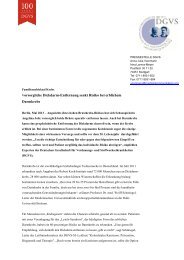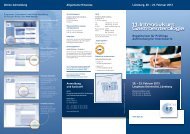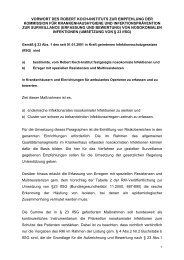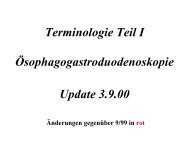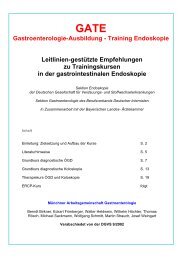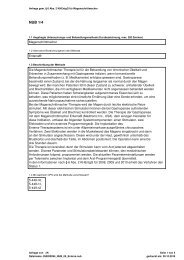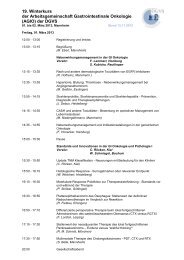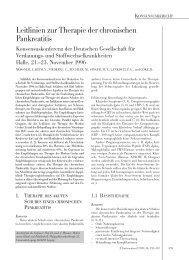Aszites, spontan bakterielle Peritonitis, hepatorenales ... - DGVS
Aszites, spontan bakterielle Peritonitis, hepatorenales ... - DGVS
Aszites, spontan bakterielle Peritonitis, hepatorenales ... - DGVS
Sie wollen auch ein ePaper? Erhöhen Sie die Reichweite Ihrer Titel.
YUMPU macht aus Druck-PDFs automatisch weboptimierte ePaper, die Google liebt.
241 Ricart E, Soriano G, Novella MT et al. Amoxicillin-clavulanic acid versus<br />
cefotaxime in the therapy of bacterial infections in cirrhotic patients.<br />
J Hepatol 2000; 32: 596–602<br />
242 Acevedo JC, Fernandez J, Castro M et al. Current efficacy of recommended<br />
empirical antibiotic therapy in patients with cirrhosis and bacterial<br />
infection (Abstract). J Hepatol 2009; 50: S5<br />
243 Castellote J, Ariza X, Girbau A et al. Risk factors to cefotaxime-resistant<br />
<strong>spontan</strong>eous bacterial peritonitis (Abstract). J Hepatol 2010; 52: S69<br />
244 Angeloni S, Leboffe C, Parente A et al. Efficacy of current guidelines for<br />
the treatment of <strong>spontan</strong>eous bacterial peritonitis in the clinical<br />
practice. World J Gastroenterol 2008; 14: 2757–2762<br />
245 Yakar T, Guclu M, Serin E et al. A recent evaluation of empirical cephalosporin<br />
treatment and antibiotic resistance of changing bacterial<br />
profiles in <strong>spontan</strong>eous bacterial peritonitis. Dig Dis Sci 2010; 55:<br />
1149–1154<br />
246 Castellote J, Ariza X, Girbau A et al. Antibiotic-resistant bacteria in<br />
<strong>spontan</strong>eous bacterial peritonitis. Is it time to change? (Abstract).<br />
J Hepatol 2010; 52: S69<br />
247 Cheong HS, Kang CI, Lee JA et al. Clinical significance and outcome of<br />
nosocomial acquisition of <strong>spontan</strong>eous bacterial peritonitis in patients<br />
with liver cirrhosis. Clin Infect Dis 2009; 48: 1230–1236<br />
248 Dupeyron C, Mangeney N, Sedrati L et al. Rapid emergence of quinolone<br />
resistance in cirrhotic patients treated with norfloxacin to prevent<br />
<strong>spontan</strong>eous bacterial peritonitis. Antimicrob Agents Chemother<br />
1994; 38: 340–344<br />
249 Dupeyron C, Campillo SB, Mangeney N et al. Carriage of Staphylococcus<br />
aureus and of gram-negative bacilli resistant to third-generation<br />
cephalosporins in cirrhotic patients: a prospective assessment of<br />
hospital-acquired infections. Infect Control Hosp Epidemiol 2001;<br />
22: 427–432<br />
250 Campillo B, Dupeyron C, Richardet JP et al. Epidemiology of severe hospital-acquired<br />
infections in patients with liver cirrhosis: effect of<br />
long-term administration of norfloxacin. Clin Infect Dis 1998; 26:<br />
1066–1070<br />
251 Campillo B, Dupeyron C, Richardet JP. Epidemiology of hospital-acquired<br />
infections in cirrhotic patients: effect of carriage of methicillin-resistant<br />
Staphylococcus aureus and influence of previous antibiotic<br />
therapy and norfloxacin prophylaxis. Epidemiol Infect 2001;<br />
127: 443–450<br />
252 Song KH, Jeon JH, Park WB et al. Clinical outcomes of <strong>spontan</strong>eous<br />
bacterial peritonitis due to extended-spectrum beta-lactamaseproducing<br />
Escherichia coli and Klebsiella species: a retrospective<br />
matched case-control study. BMC Infect Dis 2009; 9: 41<br />
253 Umgelter A, Reindl W, Miedaner M et al. Failure of current antibiotic<br />
first-line regimens and mortality in hospitalized patients with <strong>spontan</strong>eous<br />
bacterial peritonitis. Infection 2009; 37: 2–8<br />
254 Chavez-Tapia NC, Soares-Weiser K, Brezis M et al. Antibiotics for <strong>spontan</strong>eous<br />
bacterial peritonitis in cirrhotic patients. Cochrane Database<br />
Syst Rev 2009: CD002232<br />
255 Chen TA, Lo GH, Lai KH et al. Single daily amikacin versus cefotaxime<br />
in the short-course treatment of <strong>spontan</strong>eous bacterial peritonitis in<br />
cirrhotics. World J Gastroenterol 2005; 11: 6823–6827<br />
256 Rastegar LA, Umrani G, Dehbashi N et al. Evaluation of the therapeutic<br />
effect of pefloxacin in comparison with ampicillin and gentamicin in<br />
cirrhotic patients with <strong>spontan</strong>eous bacterial peritonitis. Hepatogastroenterology<br />
1998; 45: 783–785<br />
257 Antillon MR, Runyon BA. Effect of marked peripheral leukocytosis on<br />
the leukocyte count in ascites. Arch Intern Med 1991; 151: 509–510<br />
258 Ljubicic N, Spajic D, Vrkljan MM et al. The value of ascitic fluid polymorphonuclear<br />
cell count determination during therapy of <strong>spontan</strong>eous<br />
bacterial peritonitis in patients with liver cirrhosis. Hepatogastroenterology<br />
2000; 47: 1360–1363<br />
259 Runyon BA, Hoefs JC. Spontaneous vs secondary bacterial peritonitis.<br />
Differentiation by response of ascitic fluid neutrophil count to antimicrobial<br />
therapy. Arch Intern Med 1986; 146: 1563–1565<br />
260 Fong TL, Akriviadis EA, Runyon BA et al. Polymorphonuclear cell count<br />
response and duration of antibiotic therapy in <strong>spontan</strong>eous bacterial<br />
peritonitis. Hepatology 1989; 9: 423–426<br />
261 Runyon BA, McHutchison JG, Antillon MR et al. Short-course versus<br />
long-course antibiotic treatment of <strong>spontan</strong>eous bacterial peritonitis.<br />
A randomized controlled study of 100 patients. Gastroenterology<br />
1991; 100: 1737–1742<br />
262 Bauer TM, Follo A, Navasa M et al. Daily norfloxacin is more effective<br />
than weekly rufloxacin in prevention of <strong>spontan</strong>eous bacterial peritonitis<br />
recurrence. Dig Dis Sci 2002; 47: 1356–1361<br />
Leitlinie 777<br />
263 Arroyo V, Gines P, Gerbes AL et al. Definition and diagnostic criteria of<br />
refractory ascites and hepatorenal syndrome in cirrhosis. International<br />
Ascites Club. Hepatology 1996; 23: 164–176<br />
264 Salerno F, Gerbes A, Gines P et al. Diagnosis, prevention and treatment<br />
of hepatorenal syndrome in cirrhosis. Gut 2007; 56: 1310–1318<br />
265 Solanki P, Chawla A, Garg R et al. Beneficial effects of terlipressin in<br />
hepatorenal syndrome: a prospective, randomized placebo-controlled<br />
clinical trial. J Gastroenterol Hepatol 2003; 18: 152–156<br />
266 Sanyal AJ, Boyer T, Garcia-Tsao G et al. A randomized, prospective,<br />
double-blind, placebo-controlled trial of terlipressin for type 1 hepatorenal<br />
syndrome. Gastroenterology 2008; 134: 1360–1368<br />
267 Martin-Llahi M, Pepin MN, Guevara M et al. Terlipressin and albumin<br />
vs albumin in patients with cirrhosis and hepatorenal syndrome: a<br />
randomized study. Gastroenterology 2008; 134: 1352–1359<br />
268 Neri S, Pulvirenti D, Malaguarnera M et al. Terlipressin and albumin in<br />
patients with cirrhosis and type I hepatorenal syndrome. Dig Dis Sci<br />
2008; 53: 830–835<br />
269 Ortega R, Gines P, Uriz J et al. Terlipressin therapy with and without<br />
albumin for patients with hepatorenal syndrome: results of a prospective,<br />
nonrandomized study. Hepatology 2002; 36: 941–948<br />
270 Saner F, Kavuk I, Lang H et al. Terlipressin and gelafundin: safe therapy<br />
of hepatorenal syndrome. Eur J Med Res 2004; 9: 78–82<br />
271 Dart AB, Mutter TC, Ruth CA et al. Hydroxyethyl starch (HES) versus<br />
other fluid therapies: effects on kidney function. Cochrane Database<br />
Syst Rev 2010: CD007594<br />
272 Fabrizi F, Dixit V, Messa P et al. Terlipressin for hepatorenal syndrome:<br />
A meta-analysis of randomized trials. Int J Artif Organs 2009; 32:<br />
133–140<br />
273 Gluud LL, Christensen K, Christensen E et al. Systematic review of randomized<br />
trials on vasoconstrictor drugs for hepatorenal syndrome.<br />
Hepatology 2010; 51: 576–584<br />
274 Sagi SV, Mittal S, Kasturi KS et al. Terlipressin therapy for reversal of<br />
type 1 hepatorenal syndrome: a meta-analysis of randomized controlled<br />
trials. J Gastroenterol Hepatol 2010; 25: 880–885<br />
275 Gerbes AL, Huber E, Gulberg V. Terlipressin for hepatorenal syndrome:<br />
continuous infusion as an alternative to i. v. bolus administration.<br />
Gastroenterology 2009; 137: 1179; author reply 1179 – 1181<br />
276 Hadengue A, Gadano A, Moreau R et al. Beneficial effects of the 2-day<br />
administration of terlipressin in patients with cirrhosis and hepatorenal<br />
syndrome. J Hepatol 1998; 29: 565–570<br />
277 Gerbes AL, Gulberg V, Waggershauser T et al. Renal effects of transjugular<br />
intrahepatic portosystemic shunt in cirrhosis: comparison of<br />
patients with ascites, with refractory ascites, or without ascites. Hepatology<br />
1998; 28: 683–688<br />
278 Guevara M, Gines P, Bandi JC et al. Transjugular intrahepatic portosystemic<br />
shunt in hepatorenal syndrome: effects on renal function and<br />
vasoactive systems. Hepatology 1998; 28: 416–422<br />
279 Brensing KA, Textor J, Perz J et al. Long term outcome after transjugular<br />
intrahepatic portosystemic stent-shunt in non-transplant cirrhotics<br />
with hepatorenal syndrome: a phase II study. Gut 2000; 47: 288–<br />
295<br />
280 Wong F, Pantea L, Sniderman K. Midodrine, octreotide, albumin, and<br />
TIPS in selected patients with cirrhosis and type 1 hepatorenal syndrome.<br />
Hepatology 2004; 40: 55–64<br />
281 Testino G, Ferro C, Sumberaz A et al. Type-2 hepatorenal syndrome<br />
and refractory ascites: role of transjugular intrahepatic portosystemic<br />
stent-shunt in eighteen patients with advanced cirrhosis awaiting<br />
orthotopic liver transplantation. Hepatogastroenterology 2003; 50:<br />
1753–1755<br />
282 Witzke O, Baumann M, Patschan D et al. Which patients benefit from<br />
hemodialysis therapy in hepatorenal syndrome? J Gastroenterol Hepatol<br />
2004; 19: 1369–1373<br />
283 Mitzner SR, Stange J, Klammt S et al. Improvement of hepatorenal syndrome<br />
with extracorporeal albumin dialysis MARS: results of a prospective,<br />
randomized, controlled clinical trial. Liver Transpl 2000; 6:<br />
277–286<br />
284 Wong F, Raina N, Richardson R. Molecular adsorbent recirculating system<br />
is ineffective in the management of type 1 hepatorenal syndrome<br />
in patients with cirrhosis with ascites who have failed vasoconstrictor<br />
treatment. Gut 2010; 59: 381–386<br />
285 Bannares R, Nevens F, Larsen FS et al. Extracorporeal liver support<br />
with the molecular adsorbent recirculating system (MARS) in patients<br />
with acute-on-chronic liver failure (AOCLF). The RELIEF trail<br />
(Abstract). J Hepatol 2010; 52: S459–S460<br />
Gerbes AL et al. S3-Leitlinie „<strong>Aszites</strong>, <strong>spontan</strong>… Z Gastroenterol 2011; 49: 749 –779<br />
Heruntergeladen von: Thieme Verlagsgruppe. Urheberrechtlich geschützt.



